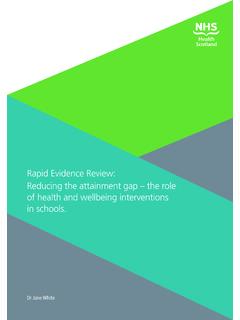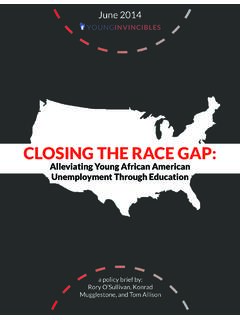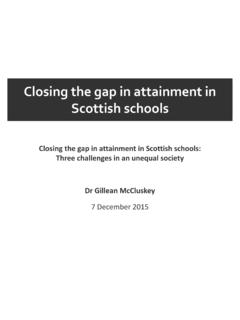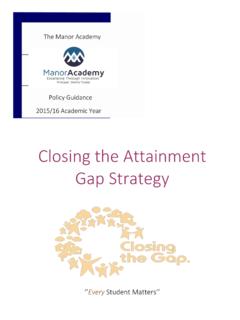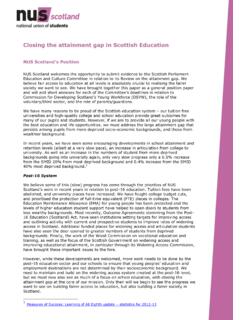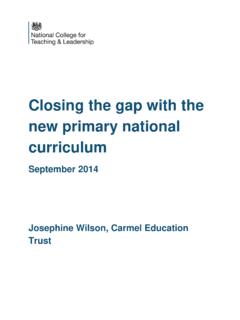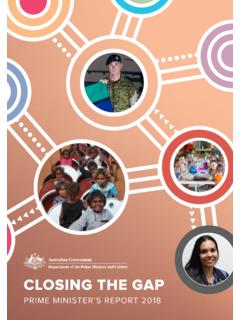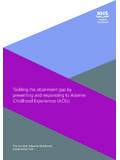Transcription of Closing the attainment gap in maths: a study of good ...
1 2 Closing the attainment gap in maths: a study of good practice in early years and primary settings Dr Catherine KnowlesAchievement for All 3 AcknowledgementsThe Fair Education Alliance would like to thank the following primary schools and early years settings that contributed to this report, particularly for their time in sharing their innovative and effective practices and approaches to mathematics: Belfield Community School, Rochdale; Elmhurst Primary School, Newham, London; Grafton Primary School, Islington, London; Parkfield Community School, Birmingham; Pound Hill Junior School, Crawley; Hillside Avenue Primary and Nursery School, Thorpe St Andrew, Norfolk; Hillmorton Primary School, Hillmorton, Rugby, Warwickshire; John Scurr, Stepney Green, London (Tower Hamlets); Victoria Lane Academy, Coundon, Durham; Wroxall Primary School, Isle of Wight; Torpoint Nursery and Infant School, Cornwall; Redcliffe Nursery School and Children s Centre, Redcliffe, Bristol; Thames Children s Centre, Blackpool; Bottesford Bunnies Pre-School, Scunthorpe, North Lincs.
2 ; Flutterbies Nursery, Rotherham; Little Owls Nursery, Scunthorpe, North Lincs.; Amanda King, Childminder, Mitchell, Newquay, Cornwall (Lollipops Childcare); Carolyn Ince, Childminder, Buckinghamshire; Charlotte Greeno, Childminder, Cambridge (city) and Sue Smith, Childminder, Ely. We also thank those who contributed ideas through our website ( ), along with our members, other organisations engaged in mathematics education and government backed organisations. And thank you to Dr Alison Borthwick of the Association of Teachers of Mathematics for her insights into primary and early years maths teaching and learning. FEA Primary Mathematics Working GroupCo-chairs: Catherine Knowles, Achievement for All and Corrine Harms, ; Liz Bayram, PACEY; Helen Drury, Mathematics Mastery; Susannah Hardyman, Action Tutoring; Colin Hegarty, Hegarty Maths; Jeremy Hodgen, University of Nottingham; Wendy Jones, National Numeracy; Ems Lord, NRICH; Lynne McClure, Cambridge Maths; Bruno Reddy, Mr Reddy Maths; Lucy Rycroft-Smith, Cambridge Richard Lambert, FEA ChairDame Julia Cleverdon, FEA Vice ChairLewis Iwu, FEA DirectorAlex Turner, FEA Coordinator3 ForewordFailure to grasp basic numeracy skills remains a persistent problem in the UK, and one that is worsening in our poorest communities.
3 Shockingly, the 2016 OECD rankings show that a gap equivalent to about eight years of schooling exists between the highest and lowest performing students in England. This has serious repercussions later in life: students who fall behind stay behind, and weak maths skills can limit life chances, leading to poor outcomes such as school exclusion, unemployment, and involvement with the criminal justice system. However, educational inequality is not inevitable. Exemplary schools, like those featured in this report, are supporting children to thrive in maths and give them the building blocks they need to succeed in life. But unfortunately these schools remain the exception rather than the rule. Closing the numeracy attainment gap is an ambitious goal and requires tactical and decisive actions that can accelerate the rate of change.
4 This report does both of those things: it provides practitioners with clear best practice examples that they can apply to their own primary school or early years setting. It also provides policymakers with a strategic blueprint for change, providing guidance on approaches that can be scaled UK remains one of the least socially mobile economies in the developed world. As a nation, we are failing to make the most of the talent on offer to us. At KPMG we recognise this, not just as a matter of fairness and equality of opportunity, but as a clear economic imperative. Indeed, social mobility is not only the golden thread that runs through almost all of our corporate responsibility programmes, it is also a key tenet of our commercial strategy, influencing how we organise ourselves and recruit talented people to our firm.
5 That is why we are committed to working with fellow members of the Fair Education Alliance, to effect real and lasting change in the area of numeracy teaching. The recommendations in this report need to be penetrated deep into schools and amplified to policymakers. There is much to do to ensure that everyone is granted the opportunity to reach their full potential, regardless of their socio-economic background. Simon CollinsChairman, KPMG UK 4 ContentsExecutive Summary 5 Introduction 8 How to develop good practice maths in your primary school 11 Primary School case studies Belfield Community School, Rochdale 13 Elmhurst Primary School, Newham, London 16 Grafton Primary School, Islington, London 19 Parkfield Community School, Birmingham 22 Pound Hill Junior School, Crawley 25 Hillside Avenue Primary and Nursery School, Thorpe St Andrew, Norfolk 29 Hillmorton Primary School, Hillmorton, Rugby, Warwickshire 32 John Scurr, Stepney Green, London (Tower Hamlets)
6 34 Victoria Lane Academy, Coundon, Durham 37 Wroxall Primary School, Isle of Wight 40 Summary: Primary Schools 43 How to develop good practice maths in your early years setting 46 Early Years case studiesSchools: Torpoint Nursery and Infant school, Cornwall 48 Children s Centres: Redcliffe Nursery School and Children s Centre, Redcliffe, Bristol 52 Thames Children s Centre, Blackpool 56 Nurseries: Bottesford Bunnies Pre-School, Scunthorpe, North Lincs. 59 Flutterbies Nursery, Rotherham 63 Little Owls Nursery, Scunthorpe, North Lincs. 66 Childminders: Amanda King, Childminder, Mitchell, Newquay, Cornwall (Lollipops Childcare) 69 Carolyn Ince, Childminder, Buckinghamshire 71 Charlotte Greeno, Childminder, Cambridge (city) 74 Sue Smith, Childminder, Ely 77 Summary.
7 Early Years settings 79 Conclusion 82 Recommendations 83 Abbreviations 84 Glossary 84 References 89 Appendices 905 Executive SummaryFindings show that when primary schools and early years settings have a whole school or setting approach to maths, children s outcomes are better and in many cases exceed expectation.
8 A whole school approach means focusing on maths across leadership, attitudes (children, teachers, practitioners, teaching assistants, parents), teaching and learning, progress and assessment, the environment, parent and carer engagement, wider opportunities and from socio-economic disadvantage are more likely to underachieve in maths throughout their school career than their more advantaged peers. In 2016 just over half of all children from disadvantaged families achieved the expected level in maths at age 11 (58%). This compared to their more advantaged peers where 76% achieved the expected level (DfE, 2016). This means that a significant proportion of children from disadvantaged families leave primary school without the basic maths skills to succeed at secondary school; strong maths skills and understanding at age 11 provide a firm base for success during secondary education and report follows on from the FEA Report Card 2015 (FEA 2016) which showed that in some areas children are better served by some schools than others.
9 Although family background has a significant impact on children s achievement in England, the case studies in this report show that with a whole school or setting approach to maths, the link between underachievement and socio-economic disadvantage can be broken. The schools and early years settings that are getting it right, as shown by these case studies, are delivering a high quality education irrespective of children s social or economic background. This report not only provides teachers and practitioners with examples of best practice which can be applied in classrooms and early years settings, it provides a strategic plan for policy makers on approaches to maths which can be scaled up. The best practice examples in this report have been identified through data and qualitative research.
10 The case studies which follow can inform teaching and learning in the sector as it strives to close the attainment gap in maths and equip children and young people with the maths skills and knowledge they need to succeed in school and beyond. Best practice in maths can close the gap. This report aims to bring together some examples of good practice in maths teaching and learning in early years settings and primary schools that are successfully Closing the attainment gap in children s maths attainment . It includes examples from education settings in some of the most deprived neighbourhoods of England as well as those in more affluent areas that are doing particularly well for their disadvantaged children; these latter schools have used pupil premium funding effectively.
